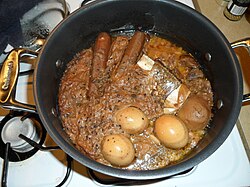|
Haminados
Haminados, also known as huevos haminados, chaminados, or braised eggs, is a traditional Sephardic Jewish dish popular in Israel. These eggs are cooked for a long time, resulting in red-brown whites and darkened yolks. The name is derived from the Hebrew word "ham," meaning "hot," reflecting the dish's preparation method. Haminados have been a component of Jewish cuisine since at least the 15th century in Medieval Spain.[1] Today, they are an integral of Israeli cuisine, typically prepared either on their own or as part of the Sephardic/Mizrahi Shabbat stew known as chamin. These braised eggs are often enjoyed as an ingredient or accompaniment in various dishes.[2][3][4][5] NameThe dish's name is haminados (guevos haminados[6] in Ladino, meaning “warmed eggs”) Historically, it was also called huebos hammados. The name derives from the Hebrew word "ham," (חם) meaning "hot,"[1] plus the ending "-ados" (perfect-passive, masculine plural), thus "made hot, heated." History The origins of haminados, or braised eggs, are rooted in the Jewish culinary traditions of Medieval Spain. During this period, eggs were a staple in daily diets and held significant symbolic meaning within Jewish culture, representing various aspects of life such as creation, mourning, and celebration.[1] Hélène Jawhara Piñer notes that during the Spanish Inquisition, traditional Jewish foods such as haminados were used as evidence against New Christians (converted Jews) for secretly adhering to Judaism. For instance, in 1490, Pedro Martínez from Soria was denounced for consuming red eggs during Lent, a period that coincided with the Jewish holiday of Passover. Later, in 1505, Alvaro de Luna was tried in Almazán after witnesses reported that he ate red eggs on Fridays and during Lent.[1] Description Haminados typically consists of whole eggs in the shell, which are placed on top of a hamin (a Shabbat stew) in the stewing pot. The eggs are braised over many hours, often overnight and turn brown in the course of all-night cooking. The brown eggs are shelled before serving and placed on top of the other cooked ingredients. In the Tunisian version, the brown eggs are cooked separately in a metal pot on the all-night stove with water and tea leaves (similar to tea eggs). Haminados can be cooked in this way even if no hamin is prepared. The addition of tea leaves, coffee grinds, or onion skins to the water dyes the shell purple and the white a light brown, giving the egg a smooth creamy texture. In Israel, brown eggs are a popular accompaniment to ful medames (a dish of mashed broad beans) and they may also be served with hummus (a dip of mashed chickpeas mixed with tahini) and in a sabich sandwich.[7] See alsoReferences
|
||||||||
